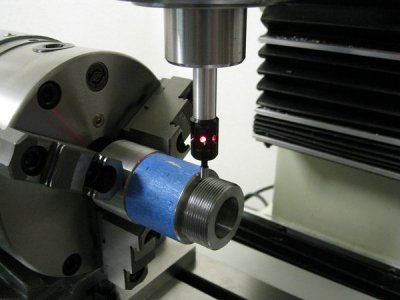- Joined
- Feb 1, 2015
- Messages
- 9,978
Hi Doug,
I use an edge finder as my preferred means of setting x and y positions. Used carefully, you can achieve repeatability to a ten thousandth.
Some things to remember about using:
I use a small amount of light machining oil to lubricate the edge finder; just a light film on the mating surfaces and wipe any excess off. You want the exterior dry. Set the spindle speed fairly low, around 750 rpm. I usually try to engage between .1 and .2" of the edge finder and to keep the consistent if I am locating the center of a piece. They work best with smooth surfaces.
When finding an edge, advance to the surface until it deflects. Note the position and back off. Come up on the edge again very slowly. You will see the edge finder runout gradually decrease as you approach the edge. The reason for doing this is that the fist contact with the edge will kick it out and you want the edge finder running true to the spindle axis. The correct position is the one closest. Repeat the process until you are satisfied with your position.
With a DRO, this process is slick. I have a Grizzly DRO on my old mill/drill and finding the center of a workpiece is apiece of cake. Find one edge, zero the DRO and find the opposite edge. Hit the 1/2 button and the DRO is centered on your workpiece. My Tormach CNC requires doing some math but works the same.
I find that the effective edge finder diameter varies slightly from the nominal. A .5000" diameter edge finder should be .2500" from the edge when it deflects but depending on rpm, surface condition, depth of engagement, etc. it will vary slightly, usually a few ten thousandths. For most work it is sufficient. Milling cutters will also cut a different diameter from their nominal depending upon runout, tool deflection and actual diameter. For precision work, it is best to sneak up with your cut as you have done.
I use an edge finder as my preferred means of setting x and y positions. Used carefully, you can achieve repeatability to a ten thousandth.
Some things to remember about using:
I use a small amount of light machining oil to lubricate the edge finder; just a light film on the mating surfaces and wipe any excess off. You want the exterior dry. Set the spindle speed fairly low, around 750 rpm. I usually try to engage between .1 and .2" of the edge finder and to keep the consistent if I am locating the center of a piece. They work best with smooth surfaces.
When finding an edge, advance to the surface until it deflects. Note the position and back off. Come up on the edge again very slowly. You will see the edge finder runout gradually decrease as you approach the edge. The reason for doing this is that the fist contact with the edge will kick it out and you want the edge finder running true to the spindle axis. The correct position is the one closest. Repeat the process until you are satisfied with your position.
With a DRO, this process is slick. I have a Grizzly DRO on my old mill/drill and finding the center of a workpiece is apiece of cake. Find one edge, zero the DRO and find the opposite edge. Hit the 1/2 button and the DRO is centered on your workpiece. My Tormach CNC requires doing some math but works the same.
I find that the effective edge finder diameter varies slightly from the nominal. A .5000" diameter edge finder should be .2500" from the edge when it deflects but depending on rpm, surface condition, depth of engagement, etc. it will vary slightly, usually a few ten thousandths. For most work it is sufficient. Milling cutters will also cut a different diameter from their nominal depending upon runout, tool deflection and actual diameter. For precision work, it is best to sneak up with your cut as you have done.

